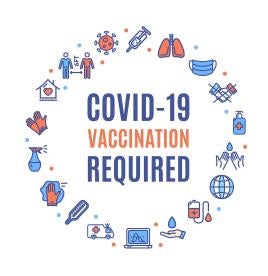Since the beginning of the COVID-19 pandemic, employers have dealt with many challenges related to ensuring a safe and healthy workplace for their employees. With the persistence of the highly transmissible Delta and Delta Plus variants, the rise in the number of positive tests and cases, and the potential impact of other variants, employers are wondering whether to delay the return of employees still working remotely and what safety measures should be implemented for those in the workplace. Some employers have re-implemented procedures that had been lifted, such as requiring all employees (vaccinated or not) to wear masks and limiting in-person meetings and other gatherings.
As part of this analysis, many employers are debating whether to mandate the COVID-19 vaccine for their employees. While several large private employers, including Disney, Google, Facebook, United Airlines, and Tyson Foods, have implemented vaccine mandates, other employers remain hesitant to take that step. Further, employers who want to mandate the vaccine may not know the best way to do so.
A vaccine mandate comes with various legal and practical risks, especially because relevant legal precedent and guidance surrounding an employer’s ability to mandate the COVID-19 vaccine is still fairly limited. Employers considering mandating vaccinations may wish to consider the following:
-
Percentage of Vaccinated Employees. Employers can ask about an employee’s vaccination status and even require proof of vaccination. The percentage of vaccinated workers may help employers determine whether a mandate is needed or how the mandate should be enforced.
-
Community Vaccination and Infection Rates. In addition to vaccination rates in the workplace, employers also may consider vaccination and infection rates in their local communities. This information can provide employers with some idea of the likelihood of employees being exposed and infected, infection trends, and also help them determine whether a mandate is needed.
-
Government Orders and Laws. The general consensus is that a federal nationwide vaccination mandate is unlikely, as the government’s authority to institute such a mandate is unclear. By contrast, it is well-established that states and municipalities have authority to mandate vaccines to protect public health. Some states and municipalities already have mandated vaccinations for certain groups of workers or facilities, such as workers in nursing homes, long-term care facilities, or health care and/or group facilities in general. On the other hand, several states have enacted laws with prohibitions on vaccine mandates. The majority of these laws against mandates apply only to state and local governments; employers and private schools in those states may still require vaccinations.
-
Feasibility of Reasonable Accommodations for Those Who Are Exempt. Although the Equal Employment Opportunity Commission (EEOC) has taken the position that employers may mandate the COVID-19 vaccine, employers must make exceptions for certain employees because of disabilities, medical contraindications, or sincerely-held religious beliefs. Under those circumstances, employers may need to engage in a reasonable accommodation process to determine whether and how reasonable accommodations can be provided. The employer will be required to provide the employee with a reasonable accommodation to the vaccination requirement unless it would pose an undue hardship or a direct threat to the workplace which cannot be mitigated. Employers must be prepared to identify and handle such exemption requests. More information regarding the EEOC’s guidance on COVID-19 vaccinations in the workplace can be found here.
-
Current Lack of Full FDA Approval for Some Vaccines. While the U.S. Food and Drug Administration (FDA) has now granted full approval to the Pfizer vaccine, Moderna and Johnson & Johnson’s Janssen vaccine maintain Emergency Use Authorization (EUA) status. This distinction may be important to employers because the Food, Drug, and Cosmetic Act (FDCA) includes a condition that potential recipients of an EUA product “are informed” of certain things, including “the option to accept or refuse [vaccination] administration.” Given that different vaccine clinics and other locations offering vaccines typically only offer one type, employers may want to consider how to provide information to employees regarding availability of certain vaccines or consider allowing more time for employees to obtain a particular vaccine.
-
Collective Bargaining Obligations. Implementation of a vaccine requirement is likely a mandatory subject for collective bargaining, requiring employers to negotiate with the union representing unionized employees. Also, the union may request bargaining about the impact of a decision to mandate vaccination, requiring bargaining about issues like testing, union representation through the exemption process, and leave requests.
-
Concerns of Vaccinated Employees. Vaccinated employees may be worried about interacting with colleagues in the workplace who are unvaccinated. Employees may have young children at home who are unable to get the vaccine or family members living in the same household who are immunocompromised. Some employees may feel their employer should take more action with regard to vaccinations in order to ensure a safe and healthy workplace. Section 5(a)(1) of the Occupational Safety and Health Act contains a general duty clause which may provide such employees with a tool to support a claim that the employer failed to provide a safe and healthy work environment.
Employers may wish to consider all options to determine what measures work best for their own workplace:
Option #1: Encourage Rather than Mandate
One option is to encourage, rather than mandate, the vaccine. This may include offering various incentives, such as cash, time off, transportation to employees related to receiving the vaccine, educating employees, and/or having management lead by example. Employers who still see a high percentage of unvaccinated individuals, however, may feel a mandate is more appropriate.
Option #2: Implement a Soft Mandate
Some employers have recently opted for a “soft mandate.” The soft mandate requires that unvaccinated employees practice certain precautions, such as wearing masks, social distancing, and weekly testing; employers also may limit or prohibit unvaccinated employees from work-related travel. This approach has been encouraged by President Biden for federal workers and contractors, and certain cities and states (such as New York City and the State of California) are taking similar approaches for their public workers. However, given reports that the virus can infect and be transmitted even by vaccinated employees, some of the precautions noted above (such as masking and social distancing) may be appropriate for all employees.
Option #3: Health Plan Premium Surcharges
Some employers are considering implementing a premium surcharge for unvaccinated employees participating in the employer’s health plan as an alternative to terminating unvaccinated employees. These surcharges are likely to range from twenty to fifty dollars, similar to surcharges imposed for employees who smoke. Delta Airlines, however, recently imposed a two-hundred-dollar surcharge per month on unvaccinated employees. COVID-19 diagnoses are likely to generate higher costs and health insurance premiums due to serious illness or hospitalization. However, this may violate the Americans with Disabilities Act (ADA) due to discrimination based on a health-related condition and as there is limited data evidencing unvaccinated employees actually result in higher costs compared to vaccinated employees.
Option #4: Implement a Hard Mandate
Of course, employers may pursue mandates with strong enforcement measures, such as termination, for employees who choose not to be vaccinated. Employers who impose a hard mandate should consider how much time is appropriate for allowing employees to become vaccinated. Because the Pfizer vaccine requires four weeks between the first and second doses, and another two weeks before the vaccine is fully effective, this timing should be considered in setting a time period. Similarly, employers may want to consider whether and how they would like to help provide access to the vaccine, such as by paying for transportation, providing time off from work, or holding a clinic at the workplace. Employers also should consider how they will communicate and distribute information regarding the COVID-19 vaccine and any associated policies to employees and employee expectations, how they will track which employees who have obtained the vaccine, and how they will address relevant questions or concerns from employees. Additionally, employers may find it helpful to provide their employees with information regarding the business reasons for the mandate and the benefits of the mandate. Employees terminated for not complying with their employer’s vaccine mandate may not be eligible for unemployment benefits; their ability to do so will likely depend on state regulations as well as the appetite of unemployment compensation commissions (and employers) to deprive workers of any benefits.
Employers are encouraged to speak with competent legal counsel about these issues.





 i
i



